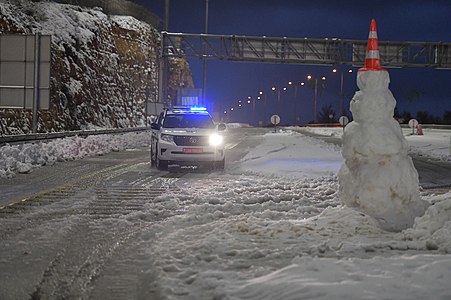
Laconia or Lakonia is a historical and administrative region of Greece located on the southeastern part of the Peloponnese peninsula. Its administrative capital is Sparta. The word laconic—to speak in a blunt, concise way—is derived from the name of this region, a reference to the ancient Spartans who were renowned for their verbal austerity and blunt, often pithy remarks.

Heraklion or Herakleion, sometimes Iraklion, is the largest city and the administrative capital of the island of Crete and capital of Heraklion regional unit. It is the fourth largest city in Greece with a municipal population of 177,064 and 211,370 in its wider metropolitan area, according to the 2011 census.

Lavrio, Lavrion or Laurium is a town in southeastern part of Attica, Greece. It is part of Athens metropolitan area and the seat of the municipality of Lavreotiki. Laurium was famous in Classical antiquity for its silver mines, which was one of the chief sources of revenue of the Athenian state. The metallic silver was mainly used for coinage. The Archaeological Museum of Lavrion shows much of the story of these mines.

Kallithea is a suburb in Athens agglomeration and a municipality in south Athens regional unit. It is the eighth largest municipality in Greece, as well as the fourth biggest in the Athens urban area. Additionally, it is the 2nd most densely populated municipality in Greece and one of the most densely populated cities in the world, with 20,240/km2 (52,400/sq mi). The municipality has an area of 4.749 km2 (1.834 sq mi).
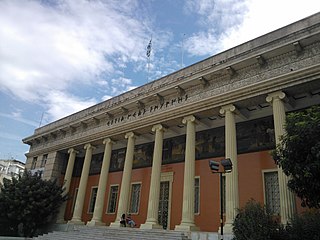
Nea Smyrni is a municipality and a town in South Athens, Greece. According to the 2011 census, it had 73,076 inhabitants. It was named after the former Greek city Smyrna, whence many refugees arrived and settled in the Nea Smyrni area following the 1922 catastrophe of Asia Minor and the Great fire of Smyrna, as a result of the Greco-Turkish war.
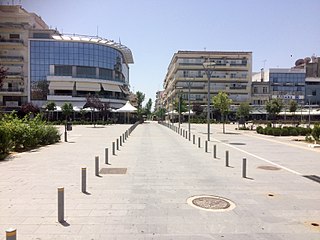
Orestiada, is the northeasternmost, northernmost and newest city of Greece and the second largest town of the Evros regional unit of Thrace. Founded by Greek refugees from Edirne after the Treaty of Lausanne when the population exchange occurred between Turkey and Greece, in which the river Evros became the new border between the two countries. The population is around 20,000.

Ampelokipoi or Ampelokipi, meaning 'vineyards', is a large, central district of the city of Athens. Ampelokipoi is in the center of Athens, near Zografou, Goudi, Psychiko and Pagkrati. The area is famous for hosting Panathinaikos's home ground since it was inaugurated in 1922.
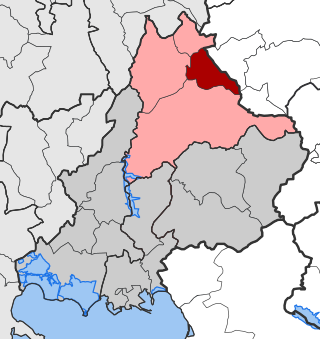
Theodoriana is a village and former community in the Arta regional unit, Epirus, Greece. Since the 2011 local government reform, it is part of the municipality, Central Tzoumerka, of which it is a municipal unit. The municipal unit has an area of 44.398 km2. In 2011 its population was 163 for the village and 173 for the community. Northeast is the Trikala regional unit. The Pindos and the Athamanian mountains cross the northeastern part. The Acheloos river flows by the village along with the GR-30.

Falasarna or Phalasarna is a Greek harbour town at the west end of Crete that flourished during the Hellenistic period. The currently visible remains of the city include several imposing sandstone towers and bastions, with hundreds of meters of fortification walls protecting the town, and a closed harbor, meaning it is protected on all sides by city walls. The harbor is ringed by stone quays with mooring stones, and connected to the sea through two artificial channels. Notable finds in the harbor area include public roads, wells, warehouses, an altar, and baths. Most of these structures were revealed by excavations that began in 1986.

Kajmakčalan (Kaimakchalan), or Kaimaki or Kaimaktsalan or Voras, is a mountain on the border between Greece and North Macedonia. It is the southernmost and highest peak, 2,521 metres (8,271 ft), of a range known in Greek as the Voras Mountains and in Macedonian as Nidže. In terms of prominence, the Kaimaktsalan summit rises 1,758 metres above its surroundings. The frontier between the two countries runs across the summit. It is the third-highest peak in Greece after Mytikas and Smolikas and the fifth-highest in North Macedonia.
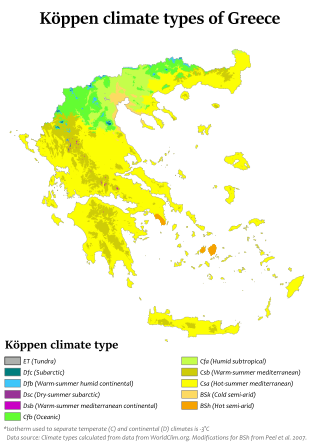
The climate in Greece is predominantly Mediterranean. However, due to the country's geography, Greece has a wide range of micro-climates and local variations. The Greek mainland is extremely mountainous, making Greece one of the most mountainous countries in Europe. To the west of the Pindus mountain range, the climate is generally wetter and has some maritime features. The east of the Pindus mountain range is generally drier and windier in summer. The highest peak is Mount Olympus, 2,918 metres (9,573 ft). The northern areas of Greece have a transitional climate between the continental, the Mediterranean and the humid subtropical climate. There are mountainous areas that have an alpine climate. Also, various areas of Greece have semi-arid climates.

Sparta is a city and municipality in Laconia, Peloponnese, Greece. It lies at the site of ancient Sparta within the Evrotas Valley. The municipality was merged with six nearby municipalities in 2011, for a total population of 35,259, of whom 17,408 lived in the city.

Harokopio University of Athens, HUA is a public research university based in Kallithea, Athens, Greece.
Vasilios Vouzas is a Greek professional football manager and former player.

The Agia Sophia Stadium, also known as OPAP Arena for sponsorship reasons and as AEK Arena for UEFA competitions, is the home stadium of AEK Athens. With an all-seater capacity of 32,500 it is the second largest football stadium overall in Greece. It is located in Nea Filadelfeia, a northwestern suburb of Athens, Greece. The new arena was built on the site of the former Nikos Goumas Stadium. The construction of the arena was completed in October 2022. Agia Sophia Stadium is the newest stadium built in Greece.

The 2021–22 European windstorm season was the seventh instance of seasonal European windstorm naming in Europe. This was the third season in which the Netherlands participated, alongside the meteorological agencies of Ireland and the United Kingdom. The season's storm names were released on 1 September 2021. Storms that occurred up until 31 August 2022 were included in this season. The Portuguese, Spanish, French and Belgian meteorological agencies collaborated again, for the fifth time, joined by the Luxembourg meteorological agency. This was the first season when Greece, Israel and Cyprus, and Italy, Slovenia, Croatia, Montenegro, North Macedonia and Malta named storms which affected their areas.

The 2022–23 European windstorm season is the deadliest and costliest European windstorm season on record, mainly because of Storm Daniel, which became the deadliest and costliest medicane ever recorded as well as the deadliest tropical or subtropical system worldwide since 2008.

The Evrotas Valley is an 82 km elongated valley between Taygetus and Parnon which traverses Laconia, Greece. Homer called the valley Kili Lakedemon, while Sparta, Mystras and Gytheio are the main cities within the valley. It is one of the largest valleys in Greece. The valley is predominantly an agricultural region that contains many citrus groves, olive groves, and pasture lands. It is the location of the largest orange production in the Peloponnese and probably in all of Greece. Lakonia, a brand of orange juice, is based in Amykles. The Evrotas Valley records the highest summer mean maximum temperatures in Greece.



